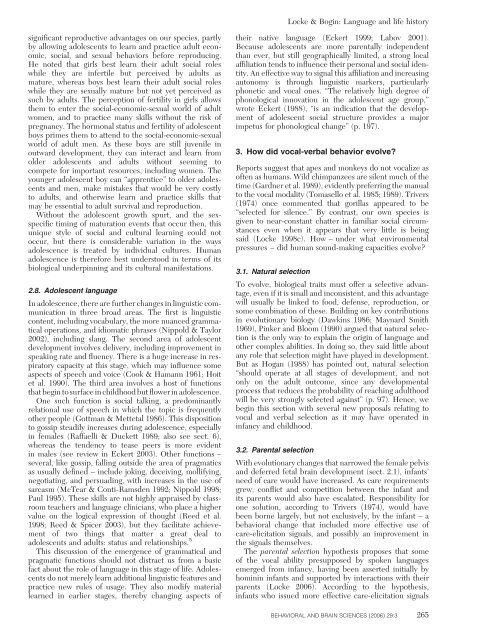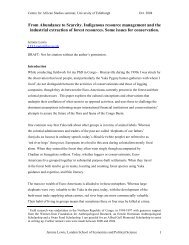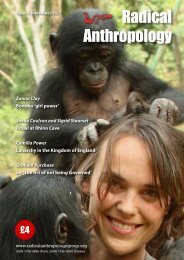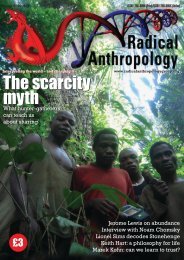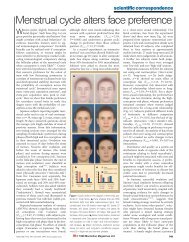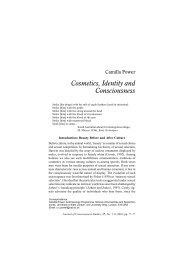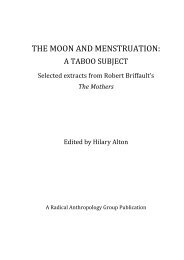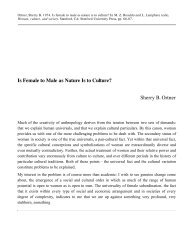Language and life history: A new perspective on the development ...
Language and life history: A new perspective on the development ...
Language and life history: A new perspective on the development ...
- No tags were found...
Create successful ePaper yourself
Turn your PDF publications into a flip-book with our unique Google optimized e-Paper software.
Locke & Bogin: <str<strong>on</strong>g>Language</str<strong>on</strong>g> <str<strong>on</strong>g>and</str<strong>on</strong>g> <str<strong>on</strong>g>life</str<strong>on</strong>g> <str<strong>on</strong>g>history</str<strong>on</strong>g>significant reproductive advantages <strong>on</strong> our species, partlyby allowing adolescents to learn <str<strong>on</strong>g>and</str<strong>on</strong>g> practice adult ec<strong>on</strong>omic,social, <str<strong>on</strong>g>and</str<strong>on</strong>g> sexual behaviors before reproducing.He noted that girls best learn <strong>the</strong>ir adult social roleswhile <strong>the</strong>y are infertile but perceived by adults asmature, whereas boys best learn <strong>the</strong>ir adult social roleswhile <strong>the</strong>y are sexually mature but not yet perceived assuch by adults. The percepti<strong>on</strong> of fertility in girls allows<strong>the</strong>m to enter <strong>the</strong> social-ec<strong>on</strong>omic-sexual world of adultwomen, <str<strong>on</strong>g>and</str<strong>on</strong>g> to practice many skills without <strong>the</strong> risk ofpregnancy. The horm<strong>on</strong>al status <str<strong>on</strong>g>and</str<strong>on</strong>g> fertility of adolescentboys primes <strong>the</strong>m to attend to <strong>the</strong> social-ec<strong>on</strong>omic-sexualworld of adult men. As <strong>the</strong>se boys are still juvenile inoutward <strong>development</strong>, <strong>the</strong>y can interact <str<strong>on</strong>g>and</str<strong>on</strong>g> learn fromolder adolescents <str<strong>on</strong>g>and</str<strong>on</strong>g> adults without seeming tocompete for important resources, including women. Theyounger adolescent boy can “apprentice” to older adolescents<str<strong>on</strong>g>and</str<strong>on</strong>g> men, make mistakes that would be very costlyto adults, <str<strong>on</strong>g>and</str<strong>on</strong>g> o<strong>the</strong>rwise learn <str<strong>on</strong>g>and</str<strong>on</strong>g> practice skills thatmay be essential to adult survival <str<strong>on</strong>g>and</str<strong>on</strong>g> reproducti<strong>on</strong>.Without <strong>the</strong> adolescent growth spurt, <str<strong>on</strong>g>and</str<strong>on</strong>g> <strong>the</strong> sexspecifictiming of maturati<strong>on</strong> events that occur <strong>the</strong>n, thisunique style of social <str<strong>on</strong>g>and</str<strong>on</strong>g> cultural learning could notoccur, but <strong>the</strong>re is c<strong>on</strong>siderable variati<strong>on</strong> in <strong>the</strong> waysadolescence is treated by individual cultures. Humanadolescence is <strong>the</strong>refore best understood in terms of itsbiological underpinning <str<strong>on</strong>g>and</str<strong>on</strong>g> its cultural manifestati<strong>on</strong>s.2.8. Adolescent languageIn adolescence, <strong>the</strong>re are fur<strong>the</strong>r changes in linguistic communicati<strong>on</strong>in three broad areas. The first is linguisticc<strong>on</strong>tent, including vocabulary, <strong>the</strong> more nuanced grammaticaloperati<strong>on</strong>s, <str<strong>on</strong>g>and</str<strong>on</strong>g> idiomatic phrases (Nippold & Taylor2002), including slang. The sec<strong>on</strong>d area of adolescent<strong>development</strong> involves delivery, including improvement inspeaking rate <str<strong>on</strong>g>and</str<strong>on</strong>g> fluency. There is a huge increase in respiratorycapacity at this stage, which may influence someaspects of speech <str<strong>on</strong>g>and</str<strong>on</strong>g> voice (Cook & Hamann 1961; Hoitet al. 1990). The third area involves a host of functi<strong>on</strong>sthat begin to surface in childhood but flower in adolescence.One such functi<strong>on</strong> is social talking, a predominantlyrelati<strong>on</strong>al use of speech in which <strong>the</strong> topic is frequentlyo<strong>the</strong>r people (Gottman & Mettetal 1986). This dispositi<strong>on</strong>to gossip steadily increases during adolescence, especiallyin females (Raffaelli & Duckett 1989; also see sect. 6),whereas <strong>the</strong> tendency to tease peers is more evidentin males (see review in Eckert 2003). O<strong>the</strong>r functi<strong>on</strong>s –several, like gossip, falling outside <strong>the</strong> area of pragmaticsas usually defined – include joking, deceiving, mollifying,negotiating, <str<strong>on</strong>g>and</str<strong>on</strong>g> persuading, with increases in <strong>the</strong> use ofsarcasm (McTear & C<strong>on</strong>ti-Ramsden 1992; Nippold 1998;Paul 1995). These skills are not highly appraised by classroomteachers <str<strong>on</strong>g>and</str<strong>on</strong>g> language clinicians, who place a highervalue <strong>on</strong> <strong>the</strong> logical expressi<strong>on</strong> of thought (Reed et al.1998; Reed & Spicer 2003), but <strong>the</strong>y facilitate achievementof two things that matter a great deal toadolescents <str<strong>on</strong>g>and</str<strong>on</strong>g> adults: status <str<strong>on</strong>g>and</str<strong>on</strong>g> relati<strong>on</strong>ships. 5This discussi<strong>on</strong> of <strong>the</strong> emergence of grammatical <str<strong>on</strong>g>and</str<strong>on</strong>g>pragmatic functi<strong>on</strong>s should not distract us from a basicfact about <strong>the</strong> role of language in this stage of <str<strong>on</strong>g>life</str<strong>on</strong>g>. Adolescentsdo not merely learn additi<strong>on</strong>al linguistic features <str<strong>on</strong>g>and</str<strong>on</strong>g>practice <str<strong>on</strong>g>new</str<strong>on</strong>g> rules of usage. They also modify materiallearned in earlier stages, <strong>the</strong>reby changing aspects of<strong>the</strong>ir native language (Eckert 1999; Labov 2001).Because adolescents are more parentally independentthan ever, but still geographically limited, a str<strong>on</strong>g localaffiliati<strong>on</strong> tends to influence <strong>the</strong>ir pers<strong>on</strong>al <str<strong>on</strong>g>and</str<strong>on</strong>g> social identity.An effective way to signal this affiliati<strong>on</strong> <str<strong>on</strong>g>and</str<strong>on</strong>g> increasingaut<strong>on</strong>omy is through linguistic markers, particularlyph<strong>on</strong>etic <str<strong>on</strong>g>and</str<strong>on</strong>g> vocal <strong>on</strong>es. “The relatively high degree ofph<strong>on</strong>ological innovati<strong>on</strong> in <strong>the</strong> adolescent age group,”wrote Eckert (1988), “is an indicati<strong>on</strong> that <strong>the</strong> <strong>development</strong>of adolescent social structure provides a majorimpetus for ph<strong>on</strong>ological change” (p. 197).3. How did vocal-verbal behavior evolve?Reports suggest that apes <str<strong>on</strong>g>and</str<strong>on</strong>g> m<strong>on</strong>keys do not vocalize asoften as humans. Wild chimpanzees are silent much of <strong>the</strong>time (Gardner et al. 1989), evidently preferring <strong>the</strong> manualto <strong>the</strong> vocal modality (Tomasello et al. 1985; 1989). Trivers(1974) <strong>on</strong>ce commented that gorillas appeared to be“selected for silence.” By c<strong>on</strong>trast, our own species isgiven to near-c<strong>on</strong>stant chatter in familiar social circumstanceseven when it appears that very little is beingsaid (Locke 1998c). How – under what envir<strong>on</strong>mentalpressures – did human sound-making capacities evolve?3.1. Natural selecti<strong>on</strong>To evolve, biological traits must offer a selective advantage,even if it is small <str<strong>on</strong>g>and</str<strong>on</strong>g> inc<strong>on</strong>sistent, <str<strong>on</strong>g>and</str<strong>on</strong>g> this advantagewill usually be linked to food, defense, reproducti<strong>on</strong>, orsome combinati<strong>on</strong> of <strong>the</strong>se. Building <strong>on</strong> key c<strong>on</strong>tributi<strong>on</strong>sin evoluti<strong>on</strong>ary biology (Dawkins 1986; Maynard Smith1969), Pinker <str<strong>on</strong>g>and</str<strong>on</strong>g> Bloom (1990) argued that natural selecti<strong>on</strong>is <strong>the</strong> <strong>on</strong>ly way to explain <strong>the</strong> origin of language <str<strong>on</strong>g>and</str<strong>on</strong>g>o<strong>the</strong>r complex abilities. In doing so, <strong>the</strong>y said little aboutany role that selecti<strong>on</strong> might have played in <strong>development</strong>.But as Hogan (1988) has pointed out, natural selecti<strong>on</strong>“should operate at all stages of <strong>development</strong>, <str<strong>on</strong>g>and</str<strong>on</strong>g> not<strong>on</strong>ly <strong>on</strong> <strong>the</strong> adult outcome, since any <strong>development</strong>alprocess that reduces <strong>the</strong> probability of reaching adulthoodwill be very str<strong>on</strong>gly selected against” (p. 97). Hence, webegin this secti<strong>on</strong> with several <str<strong>on</strong>g>new</str<strong>on</strong>g> proposals relating tovocal <str<strong>on</strong>g>and</str<strong>on</strong>g> verbal selecti<strong>on</strong> as it may have operated ininfancy <str<strong>on</strong>g>and</str<strong>on</strong>g> childhood.3.2. Parental selecti<strong>on</strong>With evoluti<strong>on</strong>ary changes that narrowed <strong>the</strong> female pelvis<str<strong>on</strong>g>and</str<strong>on</strong>g> deferred fetal brain <strong>development</strong> (sect. 2.1), infants’need of care would have increased. As care requirementsgrew, c<strong>on</strong>flict <str<strong>on</strong>g>and</str<strong>on</strong>g> competiti<strong>on</strong> between <strong>the</strong> infant <str<strong>on</strong>g>and</str<strong>on</strong>g>its parents would also have escalated. Resp<strong>on</strong>sibility for<strong>on</strong>e soluti<strong>on</strong>, according to Trivers (1974), would havebeen borne largely, but not exclusively, by <strong>the</strong> infant – abehavioral change that included more effective use ofcare-elicitati<strong>on</strong> signals, <str<strong>on</strong>g>and</str<strong>on</strong>g> possibly an improvement in<strong>the</strong> signals <strong>the</strong>mselves.The parental selecti<strong>on</strong> hypo<strong>the</strong>sis proposes that someof <strong>the</strong> vocal ability presupposed by spoken languagesemerged from infancy, having been asserted initially byhominin infants <str<strong>on</strong>g>and</str<strong>on</strong>g> supported by interacti<strong>on</strong>s with <strong>the</strong>irparents (Locke 2006). According to <strong>the</strong> hypo<strong>the</strong>sis,infants who issued more effective care-elicitati<strong>on</strong> signalsBEHAVIORAL AND BRAIN SCIENCES (2006) 29:3 265


